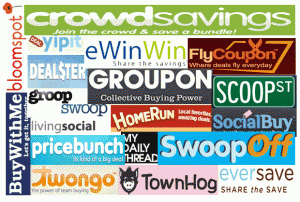“The majority of you won’t know what a coupon is, so for your own sake: it is something your gran uses to save her pennies on her groceries.” This lecturer could not have been more incorrect. Firstly, a coupon allows people to save more than just pennies and secondly, they are far from outdated, but are in fact the opposite- trendy. The article “dealer-chic” on trend watching discusses why “deals are becoming a way of life, if not a source of pride.” It summarizes why this trend will explode in the future:
1.) Consumers will always want more for less
2.) The technology associated with couponing is innovative and keeps people intrigued (and fascinated on my part)
3.) Deals are no longer heavily discounted prices on the bottom of the range products, but consumers are able to get the best of the best for less
The article mentions hundreds of deal finding sites, of which I (rather ashamedly) had only heard of three before.
After extensive research into Groupon for my class projects, my mindset on couponing has changed completely. Beforehand, I would check the deal of the day infrequently and now I find myself looking online daily to ensure I have not missed a brilliant deal. I agree with the notion that deals are “no longer considered cumbersome or even embarrassing, but simply smart.” (trendwatching) It has become an accomplishment to buy items for 50-90% less. Why would you want to pay the full price? This, however, creates a challenge for businesses because consumers are becoming more deal-prone than ever before. Thus, there is a challenge to innovate their product or service in such a way that it will avoid consumers (like me) who are discount prone.
So until businesses overcome this challenge, I will continue to participate in this growing couponing trend!





